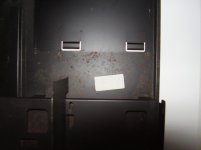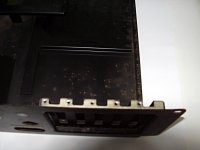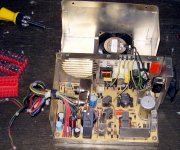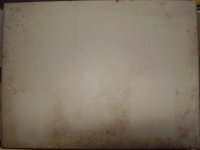ropersonline
Experienced Member
- Joined
- Jun 17, 2011
- Messages
- 153
Hi,
I have an IBM 5150 that's been out of commission for a long time and that I want to restore. I've already dusted things off, but most parts need further cleaning to de-gunk and rust-strip them.
I am particularly worried about damaging the electronics or the exterior surfaces with my cleaning.
Once the spots of rust have been removed, I reckon I may want to try to treat (and spot-paint) the case and PSU case surfaces to stop and avoid any future rust, and also to restore or at least not ruin the appearance.
How have others proceeded with such restorations?
To start off, this is a picture of the main (CPU) case tray. Sorry about my potato quality camera:

Here are two detail views that show the damage more close-up:


What cleaners should I use and avoid?
I thought about non-abrasive cleaning with general household kitchen/bathroom cleaner and water, and I have WD-40. I also have some model-making matt enamel paint. Clean, WD-40, then paint: Does that sound like a plan? Does anyone here have experience doing this? Are there any tricks to getting an even finish, even once I've touched up the rusty spots? Should I rather use spray paint?
There's rust on the power supply case and fan also (it's actually a metal fan in the PSU). Any hints on dealing with that? Just WD-40 and elbow grease?
What about the gunk on the electronics? Should I rather leave it alone, to avoid doing damage? Here's how the mainboard looks now:

I'm particularly concerned about the rust on the chip (1), about whether the electronics are damaged at (2), and whether the card slots are corroded, which could prevent cards from working (3).
Is there anything I can use to clean especially the contacts of the ISA bus cards, etc., w/o damaging them, to ensure good, corrosion-free contact? Is it a good idea or even safe to spray WD-40 on the board? What about other fluids?
I have distilled water, lighter fluid, white spirit – are any of these a bad idea on the case or electronics (even if I get everything to dry thoroughly before reassembly/switching anything back on)?
Speaking of electronics, right now, this machine hasn't been on in a long time, but once I try it again, I'm worried about capacitors holding charges and about zapping myself. Does anyone have experience on what to discharge and how to safely discharge caps or similar without damaging either the electronics or myself?
Any hints and tips --dos and don'ts-- would be very much appreciated. Thank you in advance.
I have an IBM 5150 that's been out of commission for a long time and that I want to restore. I've already dusted things off, but most parts need further cleaning to de-gunk and rust-strip them.
I am particularly worried about damaging the electronics or the exterior surfaces with my cleaning.
Once the spots of rust have been removed, I reckon I may want to try to treat (and spot-paint) the case and PSU case surfaces to stop and avoid any future rust, and also to restore or at least not ruin the appearance.
How have others proceeded with such restorations?
To start off, this is a picture of the main (CPU) case tray. Sorry about my potato quality camera:
Here are two detail views that show the damage more close-up:
What cleaners should I use and avoid?
I thought about non-abrasive cleaning with general household kitchen/bathroom cleaner and water, and I have WD-40. I also have some model-making matt enamel paint. Clean, WD-40, then paint: Does that sound like a plan? Does anyone here have experience doing this? Are there any tricks to getting an even finish, even once I've touched up the rusty spots? Should I rather use spray paint?
There's rust on the power supply case and fan also (it's actually a metal fan in the PSU). Any hints on dealing with that? Just WD-40 and elbow grease?
What about the gunk on the electronics? Should I rather leave it alone, to avoid doing damage? Here's how the mainboard looks now:
I'm particularly concerned about the rust on the chip (1), about whether the electronics are damaged at (2), and whether the card slots are corroded, which could prevent cards from working (3).
Is there anything I can use to clean especially the contacts of the ISA bus cards, etc., w/o damaging them, to ensure good, corrosion-free contact? Is it a good idea or even safe to spray WD-40 on the board? What about other fluids?
I have distilled water, lighter fluid, white spirit – are any of these a bad idea on the case or electronics (even if I get everything to dry thoroughly before reassembly/switching anything back on)?
Speaking of electronics, right now, this machine hasn't been on in a long time, but once I try it again, I'm worried about capacitors holding charges and about zapping myself. Does anyone have experience on what to discharge and how to safely discharge caps or similar without damaging either the electronics or myself?
Any hints and tips --dos and don'ts-- would be very much appreciated. Thank you in advance.
Attachments
Last edited:








